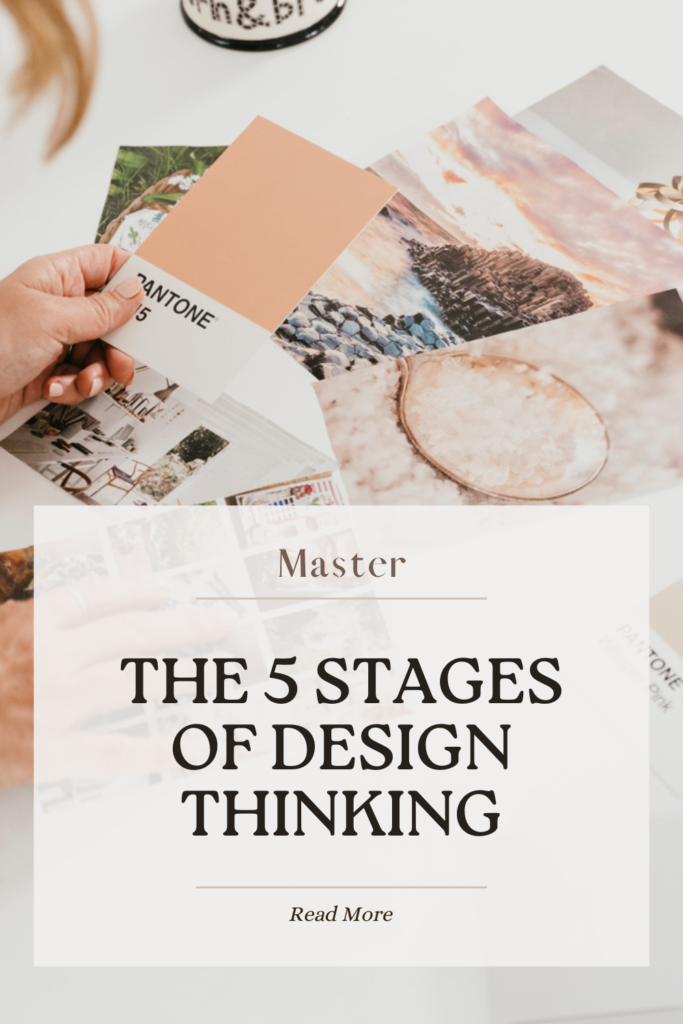As a retired Graphic Designer turned creative coach, I’ve seen firsthand how design thinking can transform not just projects, but entire careers. Whether you’re crafting brand identities, user interfaces, or anything in between, mastering design thinking can elevate your work from good to truly exceptional.
In this guide, we’ll explore the five stages of design thinking: Empathise, Define, Ideate, Prototype, and Test. But don’t worry – we won’t be approaching this like a dry academic text. Instead, think of it as a journey through a creative landscape, where each stage is a new terrain to explore and master.
Let’s dive in with a real-world scenario: imagine you’ve been approached by a local independent bookshop to refresh their brand and design a new website. They’re struggling to compete with online giants and want to revitalise their presence in the community. How would design thinking help you tackle this challenge?
Empathise: Unearthing the Story
Design thinking begins with empathy – not just understanding the brief, but truly grasping the heart of the matter. For our bookshop, this means going beyond the request for a new website.
Spend time in the bookshop. Observe how customers interact with the space. Chat with the staff about their daily challenges. Maybe even set up a small pop-up stand to engage customers directly. Ask questions like: “What brings you to this bookshop instead of ordering online?” or “What’s your favourite memory associated with this place?”
You might discover that customers value the personalised recommendations they get from staff, or that there’s a strong sense of community around their book club events. These insights are gold dust for your design process.
Define: Framing the Real Challenge
Now that you’re armed with insights, it’s time to define the core problem. The bookshop owners might think they just need a prettier website, but your research could reveal a deeper issue.
Perhaps you’ve realised that the real challenge is: “How might we translate the warm, personalised experience of the physical bookshop into a digital space, while also highlighting the unique community aspects that set this shop apart?”
This problem statement goes beyond a simple website redesign. It captures the essence of what makes the bookshop special and points towards a more holistic solution.
Ideate: Brewing a Storm of Ideas
Here’s where it gets exciting. Armed with your problem statement, it’s time to generate ideas. Don’t hold back – wild ideas often lead to innovative solutions.
Try this: Grab a stack of sticky notes and set a timer for 10 minutes. Write down every idea that comes to mind, no matter how outlandish. Could the website feature virtual ‘staff picks’ shelves that change weekly? How about a digital community board for local book clubs? Maybe an AR feature that lets online browsers ‘walk’ through the shop?
The goal is quantity over quality at this stage. You can sift through and refine later.
Prototype: Bringing Ideas to Life
Now, pick your most promising ideas and make them tangible. For our bookshop project, this might involve creating a rough wireframe of the website that showcases some of your innovative features.
You don’t need anything fancy – even a paper prototype can work wonders. Sketch out how the virtual ‘staff picks’ shelf might look, or how customers could interact with the digital community board. The goal is to have something concrete that people can react to.
Test: Learning from Feedback
Time to put your prototype to the test. Show it to the bookshop owners, staff, and a few loyal customers. Encourage honest feedback. You might ask questions like: “Does this capture the feel of the physical shop?”, “Would you use this feature?”, or “What’s missing?”
Be prepared for surprises. Maybe your AR feature idea falls flat, but customers love the concept of online book club sign-ups. Use this feedback to refine your design.
The Spiral of Innovation
Remember, design thinking isn’t a straight path from A to B. It’s more like a spiral, where you might loop back to earlier stages as you gain new insights. Your testing phase might uncover new user needs, sending you back to the empathy stage. Or it might spark new ideas, launching you back into ideation.
For our bookshop project, you might realise through testing that customers are especially excited about the idea of pre-ordering books for collection. This could send you spiralling back to redefine the problem and ideate on how to make this process seamless both online and in-store.
Embracing Design Thinking in Your Practice
By applying design thinking to the bookshop project, you’ve done more than just design a website. You’ve created a digital experience that truly captures the essence of the bookshop and addresses its core challenges.
This approach can transform how you tackle every design project. It pushes you to dig deeper, think more creatively, and create solutions that resonate on a fundamental level with users.
As you embrace design thinking, you’ll find yourself becoming more than just a designer – you’ll be a problem solver, an innovator, and a strategic partner to your clients.
Remember, mastering design thinking is a journey. It takes practice and patience. But with each project, you’ll find your designs becoming more impactful, more innovative, and more attuned to real user needs.
So, why not give it a go on your next project? You might be surprised at the fresh perspectives and innovative ideas that emerge when you approach design challenges through this lens. And who knows? You might just revolutionise your local bookshop – and your design career – in the process.



Stay inspired
Subscribe to my Newsletter
Join my community of creative professionals and receive monthly insights to fuel your design journey. You’ll get practical tips, mindset strategies, and exclusive content delivered to your inbox.
Share via:

